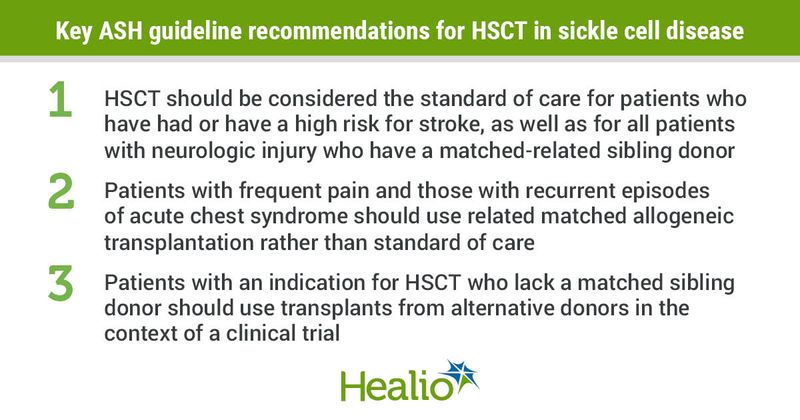ASH releases guidelines on stem cell transplantation for patients with sickle cell disease
New guidelines for sickle cell disease issued by ASH and published in Blood Advances aim to inform practitioners and patients on use of hematopoietic stem cell transplantation in clinical practice.
The guidelines outline possible risks and benefits of transplantation compared with disease-modifying treatments or potential curative therapies still under development, such as gene therapy.

“One key area where there was a real lack of information (prior to these guidelines) was regarding stem cell transplant, especially if we could identify who should get a transplant and if there was a ‘best’ regimen to use,” Julie Kanter, MD, co-director of the Comprehensive Sickle Cell Center at Heersink School of Medicine at The University of Alabama at Birmingham, told Healio.
Highlights of the guidelines included addressing the need for a clinical longitudinal registry to measure outcomes of patients who underwent HSCT vs. those who did not, Kanter said.

“We ran into a lot of issues with these guidelines because we just don’t have a lot of data. It is not ethical in the setting of transplant to do a randomized controlled trial,” Kanter said. “However, a pragmatic observational assessment can be done using a multicenter longitudinal registry. The second most important takeaway is the data available show matched sibling donors undergoing myeloablative chemotherapy have the best outcomes, especially as children. However, minimal data was available regarding haploidentical transplants. Further, as noted, rigorous comparative data have not been collected.”
ASH, with the support of the Evidence-Based Practice Research Program at Mayo Clinic, used the Grading of Recommendations Assessment, Development and Evaluation (GRADE) approach to evaluate evidence and make recommendations, which were subject to public comment.
To identify best practices for managing acute and chronic complications of sickle cell disease, as well as improving patients’ quality of care, ASH brought together 61 clinical experts, five methodologists and 10 patient representatives and prioritized clinical questions and outcomes according to their importance to clinicians and patients. The group was balanced to minimize potential bias from conflicts of interest.
“It’s definitely important to have multiple voices in the room, including the patient and family perspective,” Kanter said.
Recommendations agreed upon by the panel to help patients and providers assess the timing and type of HSCT for patients with sickle cell disease include:
- HSCT should be considered the standard of care for individuals with sickle cell disease who have had or have a high risk for stroke, as well as for all patients with neurologic injury who have a matched-related sibling donor. Evidence suggests children aged younger than 13 years who have a HSCT from a matched sibling donor have better outcomes than those aged older than 13 years.
- Patients with frequent pain and those with recurrent episodes of acute chest syndrome should use related matched allogeneic transplantation rather than standard of care.
- Patients with sickle cell disease with an indication for HSCT who lack a matched sibling donor should use transplants from alternative donors in the context of a clinical trial, with the panel noting risk related to transplantation complications should be balanced with benefits derived from successful transplantation.
- Because the risk for irreversible sickle cell disease-related damage to the body increases with age, patients with an indication for transplant should have transplantation with cells from a matched donor earlier in life.
Kanter and colleagues noted the evidence review yielded no randomized controlled clinical trials for HSCT in [sickle cell disease] and, because of that, the recommendations are based on “very low certainty in evidence.” Additionally, they reemphasized the need for a comprehensive sickle cell disease registry to serve as a comparator for future HSCT studies.
“I cannot say enough about how important a longitudinal clinical registry is in improving our knowledge and outcomes in [sickle cell disease], including quality assessment and improvement as well in clinical research,” Kanter said.
Further areas of research, she added, should be in conducting more national trials for adults with sickle cell disease undergoing HSCT, including full-matched and half-matched transplants.
“We make the recommendation for enrolling whenever possible in clinical trials (especially for non-[matched sibling] donor studies) but we have to have open studies available for that to work,” Kanter said. “If we have more data on the pretransplant outcome to compare long-term to posttransplant, we will know more about organ-specific outcomes to really make a difference for people, especially those making treatment decisions.”
References:
Kanter, et al. Blood Adv. 2021;doi:10.1182/bloodadvances.2021004394C.
ASH releases new clinical practice guidelines on stem cell transplantation in sickle cell disease. Available at: www.hematology.org/newsroom/press-releases/2021/ash-releases-new-clinical-practice-guidelines-on-stem-cell-transplantation-in-sickle-cell-disease. Published Sept. 28, 2021. Accessed Oct. 7, 2021.
For more information:
Julie Kanter, MD, can be reached at The University of Alabama at Birmingham, 1720 2nd St. South, MP 2510, Birmingham, AL 35233; email: jkanter@uabmc.edu.
